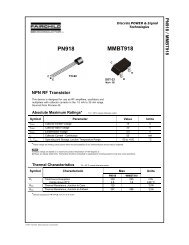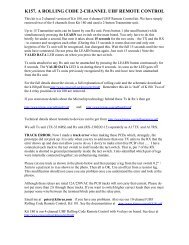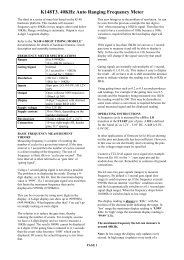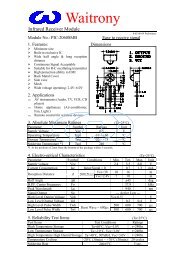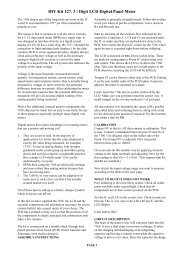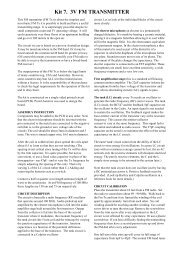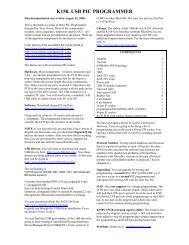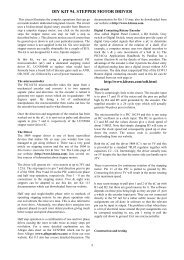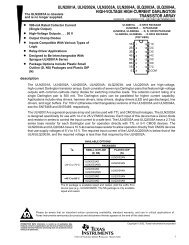KIT 126. WOOFER STOPPER - Kitsrus
KIT 126. WOOFER STOPPER - Kitsrus
KIT 126. WOOFER STOPPER - Kitsrus
You also want an ePaper? Increase the reach of your titles
YUMPU automatically turns print PDFs into web optimized ePapers that Google loves.
Barking dogs drive many people crazy and there is usually<br />
nothing you can do about it. That is up until now.<br />
The Woofer Stopper emits a blast of high intensity sound.<br />
The frequency is just out of the range of human hearing<br />
but dogs will hear it easily. Usually a few blasts is all it<br />
will take before most dogs learn that barking means<br />
punishment and stop. How effective the Woofer Stopper<br />
is will depend on the dog. Note that some dogs are deaf or<br />
so stupid that they will continue to bark anyway.<br />
However, provided that the dog is within 30 metres, the<br />
Woofer Stopper will deter most dogs from barking.<br />
<strong>KIT</strong> <strong>126.</strong> <strong>WOOFER</strong> <strong>STOPPER</strong><br />
The transformer steps up the voltage and drives the piezo<br />
tweeter(s). Piezo tweeters are basically a capacitor.<br />
Adding an inductor in series with the tweeter forms a<br />
resonant circuit, providing maximum power transfer to the<br />
tweeter and therefore a higher output level. An internal<br />
oscillator in the TL494 sets the output frequency.<br />
Capacitor C3 is charged with a constant current – the<br />
value of which is determined by resistor R7 in series with<br />
trimpot VR1. This produces a sawtooth waveform across<br />
C3. When the voltage across C3 reaches 3V, it is<br />
discharged by the internal oscillator and the charging<br />
cycle starts over again.<br />
The kit is constructed on a single-sided printed circuit<br />
board (PCB) measuring 122 x 56mm. The kit requires a<br />
10-to-16V DC power supply rated at 1/2 amp minimum.<br />
So a usual 300mA plugpack will not be able to drive it.<br />
WARNING<br />
The output from this kit is at a very high level. Even<br />
though you may not hear the noise, take care to keep<br />
away from the front of the tweeters when the kit is<br />
operating. Ear damage may occur.<br />
ASSEMBLY INSTRUCTIONS<br />
Check the components against the Component listing on<br />
the next page. Follow the component overlay on the PCB,<br />
starting with the resistors then inductors and IC socket.<br />
Use the wire offcuts from the resistor leads to fit the two<br />
wire links. Next fit the monobloc capacitors, followed by<br />
the electrolytic capacitors. Electrolytic capacitors are<br />
polarised, the positive lead is marked on the overlay, the<br />
negative is marked on the body of the capacitor.<br />
Secure the heatsinks onto the power transistors, TIP41C,<br />
using the 3mm screws and nuts. Make sure the heatsinks<br />
are “straight” before soldering the transistors into place.<br />
The heatsinks must not be touching. Add the transformer<br />
last.<br />
You have to supply your own twin cable wire for the<br />
TRIGGER push-on switch. The switch may be located<br />
some distance away from the PCB. Also you must supply<br />
your own wire to connect the TWEETER to the pcb. The<br />
position for the first tweeter is on the bottom right of the<br />
PCB. Pads are available to connect three more inductor /<br />
tweeter combinations which the circuit can drive.<br />
For just off/on use the 1/2W 120R resistors are OK. But if<br />
you are going to leave this kit on continuously then they<br />
should be replaced by 1W rated resistors<br />
CIRCUIT DESCRIPTION<br />
The circuit is based around the TL494 Pulse Width<br />
Modulation Control chip. For the data sheet go to the<br />
Texas Instrument website at www.ti.com. The output is<br />
configured for push-pull operation by connecting the<br />
“Output Control” (pin 13) to Vref (pin 14). The outputs<br />
are current boosted by transistors Q3 and Q4 and drive the<br />
primary of transformer T1.<br />
For push-pull operation, the oscillator frequency is:<br />
f<br />
OSC =<br />
1<br />
2R<br />
C<br />
X<br />
3<br />
(where R X = R7 + VR1)<br />
Resistors R1-4, capacitor C1 and the PUT form a<br />
“relaxation” oscillator. Capacitor C1 is charged via<br />
resistor R3. When the voltage across C3 reaches the<br />
breakover voltage of the PUT it fires and C1 is discharged<br />
via R4. This forms a sawtooth waveform across C1 with a<br />
frequency of approximately 4Hz. Transistor Q2 is a unity<br />
gain buffer used to minimise any loading on the capacitor.<br />
This sawtooth waveform appears at the R T input (pin 6) of<br />
the TL494 and causes the charging rate of C3 to vary.<br />
This has the effect of “modulating” the TL494 oscillator<br />
frequency and therefore the output frequency.<br />
At one extreme setting of VR1 the sweep range is approx.<br />
20-23KHz. On the other extreme setting of VR1 the<br />
sweep range is approx. 28-31khz. Modulating (sweeping)<br />
the output frequency provides a high effective output by<br />
overcoming any peaks and dips in the frequency response<br />
of the tweeters.<br />
Internally, the TL494 compares the sawtooth voltage<br />
across C3 with the voltage level at the “Dead Time” input,<br />
pin 4. The output pulses are enabled when the sawtooth<br />
voltage is greater than the “Dead Time” voltage. Normally<br />
the Dead Time input is held at about 5V. When the<br />
pushbutton is pressed the voltage level on pin 4 falls to<br />
almost zero volts and the output is enabled. The RC<br />
combination of R8, R9 & C4 prevent harsh turn-on/turnoff<br />
of the output signal. The 5V comes from a voltage<br />
regulator inside the TL494 & is output on pin 14.<br />
IF IT DOES NOT WORK<br />
Poor soldering (“dry joints”) is the most common reason<br />
for the circuit not working. Check all soldered joints<br />
carefully under a good light. Re-solder any that look<br />
suspicious.<br />
• Are all the components in their correct position on the<br />
PCB.<br />
• Are the electrolytic capacitors the right way round?<br />
• Is the IC the right way around?<br />
• Are the transistors and PUT the right way around?<br />
• Are any IC leads bent up under the IC body?<br />
PAGE 1
• Have you put in the 2 wire links?<br />
COMPONENTS<br />
Resistors, 5% carbon<br />
47R yellow violet black R11 R13 2<br />
120R 1/2W brown red brown R10 R12 2<br />
1K brown black red R4 1<br />
10K brown black orange R5 1<br />
12K brown red orange R7 1<br />
22K red red orange R9 1<br />
47K yellow violet orange R6 1<br />
68K blue grey orange R1 1<br />
100K brown black yellow R2 1<br />
470K yellow violet yellow R3 R8 2<br />
5K 502 Koa trimpot VR1 1<br />
Electrolytic capacitors;<br />
1u/50V ecap C2 1<br />
100uF C5 1<br />
470u/25V C6 1<br />
2n2 mylar capacitor C3 1<br />
.47u, 474 MPE cap C1 C4 2<br />
2N6028 PUT Q1 1<br />
BA159 diode D1 D2 2<br />
BC548 transistor Q2 1<br />
TIP41C Q3 Q4 2<br />
TL494 IC1 1<br />
16 pin IC socket 1<br />
Transformer 1<br />
Inductors 400uH 2<br />
Piezo tweeter 1<br />
HS103 heatsink 2<br />
3x8mm nut & bolt set 2<br />
Push-on switch 1<br />
K126 PCB 1<br />
<strong>KIT</strong> <strong>126.</strong> <strong>WOOFER</strong> <strong>STOPPER</strong><br />
CONTACTING US<br />
You can email us at peter@kitsrus.com if you have<br />
any problems or requests. Information on other kits in the<br />
range is available from our Web page at:<br />
http://kitsrus.com<br />
- - - - - - - - - - - - - - - - - - - - - - - - -<br />
PAGE 2
<strong>KIT</strong> <strong>126.</strong> <strong>WOOFER</strong> <strong>STOPPER</strong><br />
PAGE 3



